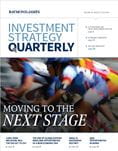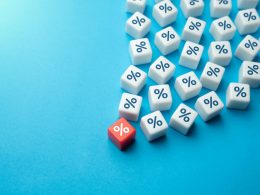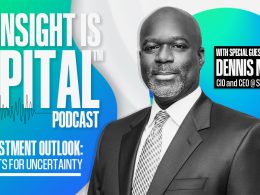by Larry Adam, CIO, Raymond James
Following a strong start to 2023, CIO Larry Adam and his team share their outlook for the remainder of the year.
To read the full article, see the Investment Strategy Quarterly publication linked below.
This year marks the 110th edition of the Tour de France, the most prestigious bicycle race in the world. And like the markets, the Tour is always challenging – and evolving. The three-week, grueling 2,200+ mile route changes every year and, surprisingly, starts in different countries – this year in Spain versus the UK, the Netherlands, Germany, Belgium, and Denmark the previous five years! The point is, just like the Tour, economic and market cycles have different starting points, and no two routes are alike.
Just look at the economic course we are currently on: It began with a historic pandemic and has since snaked through near-record inflation, a war, assorted political tensions, and unprecedented fiscal and monetary policy changes. For investors, the trip has been as exhausting as climbing the iconic Col du Tourmalet in a brutal mountain stage this year. But, as we move to the next stage of our investment journey, the goal for cyclists and investors is the same: Be ready, adjust when necessary, and maintain a long-term perspective.
The U.S. economy continues to pedal forward, defying predictions it would skid into a recession, thanks in part to the effects of unparalleled fiscal (i.e., the approximately $5 trillion pandemic-related government stimulus) and monetary stimulus (i.e., record-low interest rates and Federal Reserve (Fed) bond-buying program). Many cheered the robust labor markets, strong consumer spending and strong wage gains that resulted. Now we will see how the economy performs without artificial stimulus and on its own merits. Like Tour officials clamping down on rule breakers, the Fed is cracking down on inflation, tightening interest rates by 500 basis points (5%) over the last 15 months, boosting borrowing costs on everything from credit cards to autos. Today, with mountainous interest expenses and excess consumer savings evaporating quickly, consumers can no longer coast. Understandably buyers are showing signs of fatigue. This, combined with credit tightening and job growth slowing, suggests the economy will slide into a mild recession beginning in the fourth quarter. Despite the slowdown, this year’s fast start keeps overall 2023 GDP growth positive at 1.3%. But we do expect it to decelerate to between 0.5–0.7% in 2024.
Every cyclist’s nightmare is a chain-reaction crash, and the Fed is trying to avoid a pile-up after its interest rate hikes. Banking turmoil in March may have been the Fed’s flamme rouge: The red banner that tells cyclists they’re close to the finish line. Restrictive rates seem to be doing their job – putting the brakes on the economy. There is no question that the economic data (slowing inflation, rising jobless claims and below-trend growth) are moving in the direction the Fed wants, it’s just not happening at the pace it wants. The big question is how much patience the Fed must have to allow the disinflationary trend to continue before tightening further. Ultimately, we believe the Fed is in the latter stages, if not near the end, of its tightening cycle. We expect the federal funds rate to end the year at 5.50%. However, as the economy downshifts in 2024 and the unemployment rate nears 5%, expect the Fed to cut the fed funds rate to 4.0%.
Despite market expectations of treacherous terrain, our positive equity market outlook entering 2023 paid off: Double-digit gains by the S&P 500 are pushing it near our year-end target of 4,400 and potentially toward our 12-month target of 4,600. The good news is the equity market has technically transitioned into a bull market (up more than 20% from last October’s lows). The bad news is we’ve probably entered a new, more volatile stage. We based our early optimism on unwarranted skepticism and pessimism in the markets. Our view proved out: Earnings came in better than expected, inflation is decelerating, the US government didn’t default, and the Fed will probably dial back its interest rate hikes. Moving forward, our upside view is tempered; we see potential blind curves ahead. For example, the recent surge in investor optimism may set the market up for disappointment. But in the long term, healthy macro tailwinds, a 2023 earnings per share (EPS) target on track at $215, a broadening of sector participation, and history keep us optimistic. And there’s more potential upside if the Fed pulls off a soft, non-recessionary landing.
The Tour de France includes 21 stages over 23 days – varying from flat (6), hilly (6), mountains (8) and one individual time trial. While individual riders may win different stages of the course, the overall winner is the rider with the lowest cumulative time. In fact, three-time US winner Greg LeMond won the race in 1990 without winning a single stage. A balanced, well-rounded, and consistent long-term-focused strategy is essential – as it is for successful investors! Remember that while individual cyclists get the headlines, the race is a team sport. Up to 100 team staff members ensure cyclists get water, food, equipment, and support. Don’t go the distance alone. Reach out to your financial advisor for guidance to help you get to the finish line of your financial goals. And hopefully, like most Tours de France, you will have enough of a lead in obtaining your investment goals so that the last few miles are a leisurely procession all the way to the Champs-Élysées.

Read the full
Investment Strategy Quarterly
All expressions of opinion reflect the judgment of the Chief Investment Office, and are subject to change. This information should not be construed as a recommendation. The foregoing content is subject to change at any time without notice. Content provided herein is for informational purposes only. There is no guarantee that these statements, opinions or forecasts provided herein will prove to be correct. Past performance may not be indicative of future results. There is no assurance any investment strategy will be successful. Investing involves risk including the possible loss of capital. Companies engaged in business related to a specific sector are subject to fierce competition and their products and services may be subject to rapid obsolescence. There are additional risks associated with investing in an individual sector, including limited diversification. Asset allocation and diversification do not guarantee a profit nor protect against loss. The S&P 500 is an unmanaged index of 500 widely held stocks that is generally considered representative of the U.S. stock market. Keep in mind that individuals cannot invest directly in any index, and index performance does not include transaction costs or other fees, which will affect actual investment performance. Individual investor’s results will vary. Investing in small cap stocks generally involves greater risks, and therefore, may not be appropriate for every investor. International investing involves special risks, including currency fluctuations, differing financial accounting standards, and possible political and economic volatility. Investing in emerging markets can be riskier than investing in well-established foreign markets. Investing in the energy sector involves special risks, including the potential adverse effects of state and federal regulation and may not be suitable for all investors.
CFA® and Chartered Financial Analyst® are registered trademarks owned by CFA Institute.
Investments & Wealth Institute™ (The Institute) is the owner of the certification marks “CIMA” and “Certified Investment Management Analyst.” Use of CIMA and/or Certified Investment Management Analyst signifies that the user has successfully completed The Institute’s initial and ongoing credentialing requirements for investment management professionals.
Certified Financial Planner Board of Standards Inc. owns the certification marks CFP®, Certified financial Planner™, CFP® (with plaque design) and CFP® (with flame design) in the U.S., which it awards to individuals who successfully complete CFP Board’s initial and ongoing certification requirements.
















